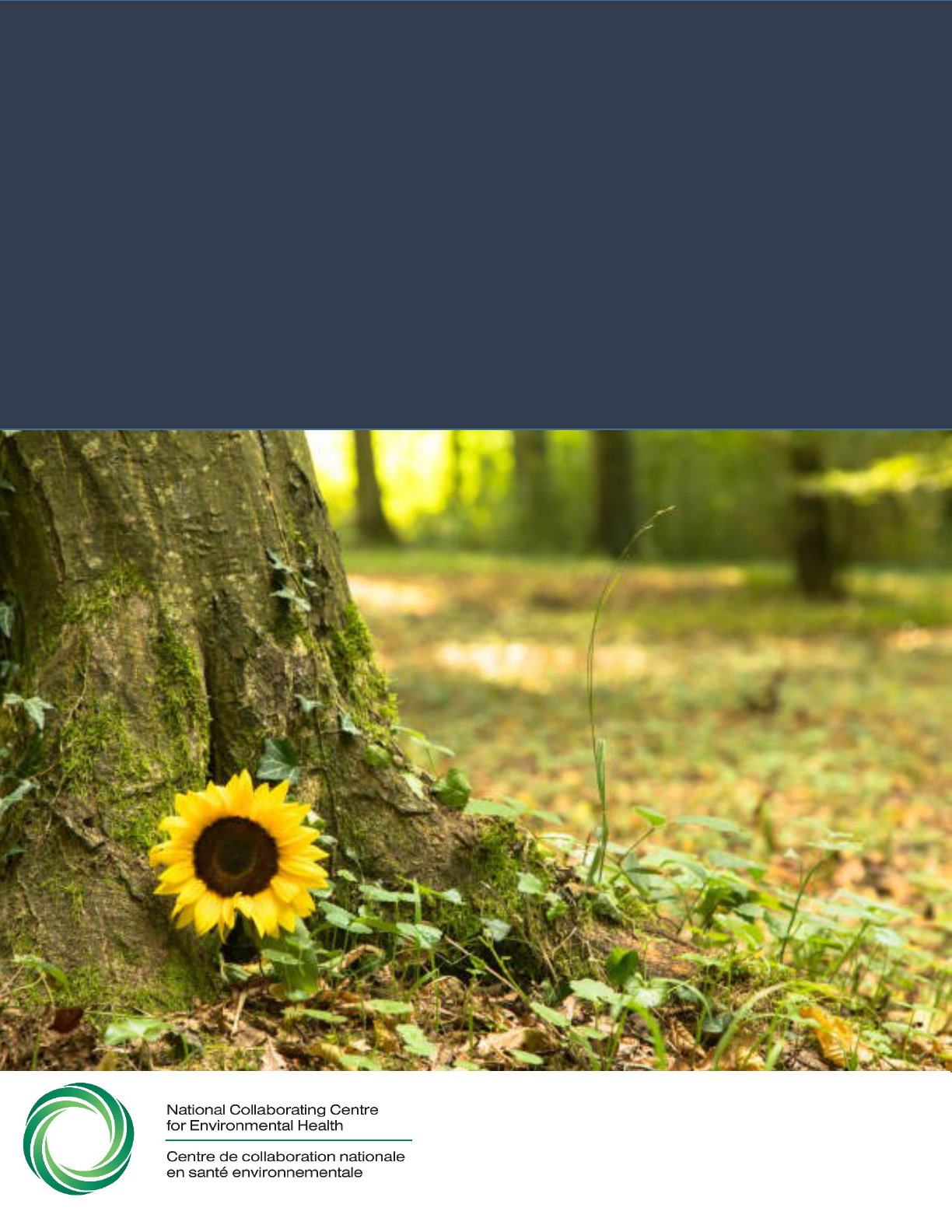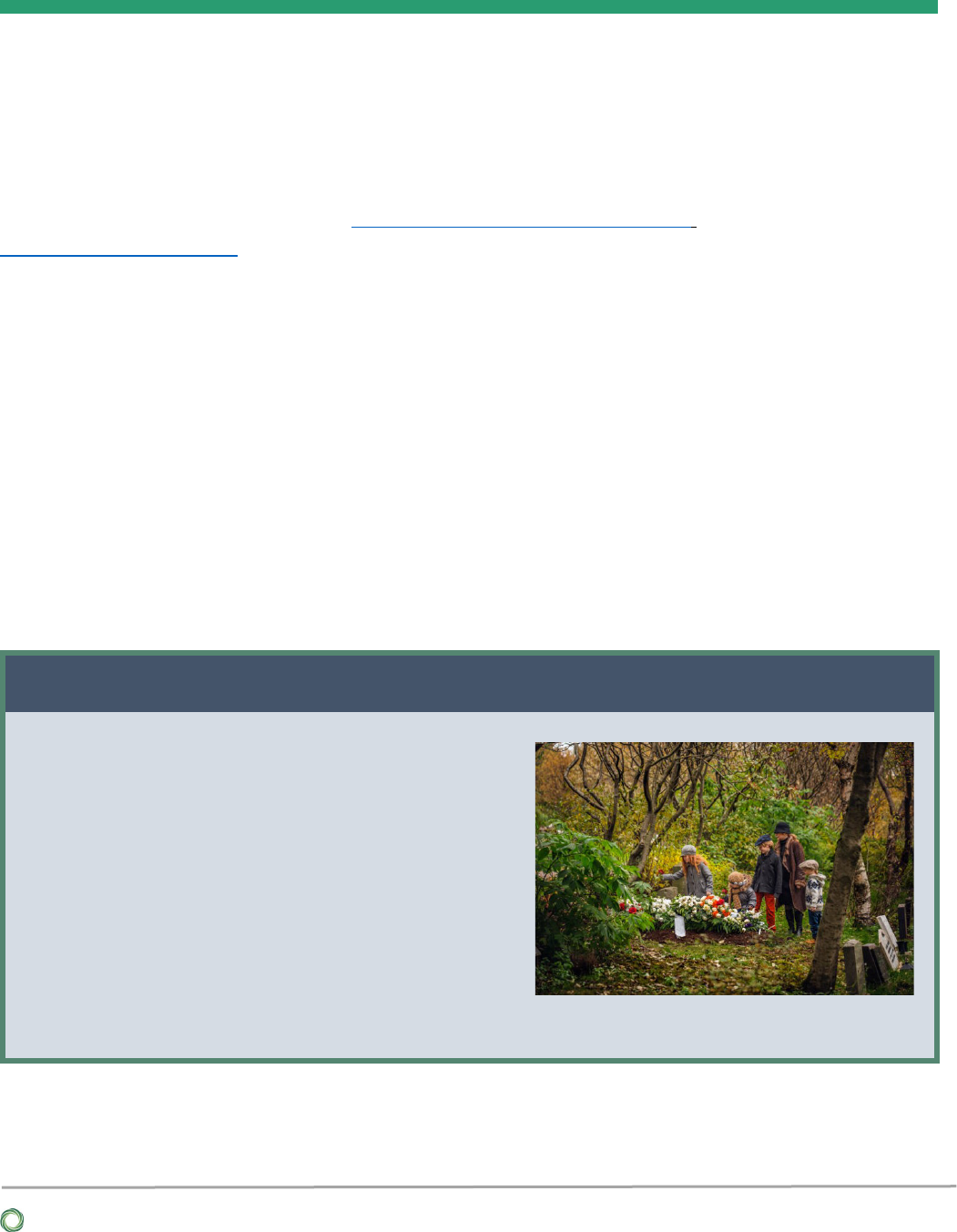
ncceh.ca
April 2023
Alternative disposition services:
Green burial, alkaline hydrolysis and
human composting
By Juliette O’Keeffe
National Collaborating Centre for Environmental Health

ALTERNATIVE DISPOSITION SERVICES: GREEN BURIAL,
ALKALINE HYDROLYSIS AND HUMAN COMPOSTING
1
Key Messages
• Public interest in new ways to dispose of human remains (alternative disposition services)
is growing, driven in part by consumer demand for more sustainable funeral options.
• Alternatives include
green burial
(permitted in most Canadian provinces and territories),
alkaline hydrolysis
(only permitted in SK, ON, QU, NL, and NWT), and
human composting
,
which is not currently permitted in any Canadian jurisdiction.
• The environmental benefits of these services are mostly derived from avoiding the use of
chemicals, energy, and materials used in conventional methods.
• The environmental health concerns include the potential for nuisance (e.g., odour,
aesthetic impacts, and traffic), water or soil pollution, and public or occupational exposure
to biological, chemical, or radiological agents.
• There has been limited scientific investigation of the scope and scale of hazards; however,
approaches to minimizing hazards could include:
o Ensuring decomposition leachate from green burial sites does not contaminate
environmental waters or drinking water sources;
o Ensuring alkaline hydrolysis process conditions are safe for operators and sufficient
to inactivate pathogens, and effluent is sufficiently treated to reduce impacts on
wastewater systems.
o Ensuring human composting operational parameters are sufficient to ensure the
inactivation of pathogens and safety of operators, and that final compost material
is managed in a way to reduce risk of operator or public exposure to biological,
chemical, or radiological agents.
• Consideration should be given to whether any disposition method is appropriate for
decedents with certain diseases or radiological implants where there is potential for
occupational or public exposure to harmful agents during handling of the deceased or from
release of decomposition leachate, effluent, or compost to the environment.
• Further study of the technical safety and the potential for nuisance or pollution could
inform regulation and good practice guidance on selecting appropriate sites, designing
operation controls, and ensuring appropriate oversight and monitoring.

ALTERNATIVE DISPOSITION SERVICES: GREEN BURIAL,
ALKALINE HYDROLYSIS AND HUMAN COMPOSTING
2
Introduction
In Canada, human remains are typically cremated or interred in cemeteries, but there is growing
consumer interest in alternatives to these conventional disposition services that offer more
environmentally sustainable end-of-life options. In response to inquiries to the NCCEH about the possible
environmental and health considerations associated with alternative disposition services, this document
seeks to provide an overview of three such services: green burial, alkaline hydrolysis, and human
composting. These services have been the subject of public interest, media attention, petitions, or
planning inquiries in various Canadian jurisdictions. Other alternative disposition practices (e.g.,
promession) and the handling of pet remains are outside the scope of this review.
This document addresses the following questions:
• What are the alternative disposition services under consideration and their proposed environmental
benefits?
• What are the environmental health concerns associated with alternative disposition services?
• What approaches can be used to minimize possible environmental health hazards of alternative
disposition?
Methodology
General approach
We used a multi-pronged approach that included consultation with individuals who have expertise on the
subject of human disposition services, alongside a rapid literature search for academic and grey literature
and public health guidance or resources relevant to the topic.
Consultation
Across Canada, oversight for human disposition is generally the responsibility of provincial or territorial
agencies, ranging from consumer protection to environment, health, or public safety Ministries (see
Appendix 1). At the local level, these oversight bodies and public health units are often called on to
comment on planning applications, and provide advice and support to operators or municipalities.
Industry bodies, while sitting outside of the regulatory regime, also provide education and support to
operators, and may set internal criteria for member certification.

ALTERNATIVE DISPOSITION SERVICES: GREEN BURIAL,
ALKALINE HYDROLYSIS AND HUMAN COMPOSTING
3
Individuals representing provincial regulators, public health units, and industry with in-depth knowledge
of disposition services currently in use or proposed were consulted. Consultees were asked for
information on the types of services being considered, key resources, regulations, or best practice
documents relevant to Canada, and the key environmental health issues that should be considered in
regulation or oversight of these services. Several consultees also assisted in providing external review of
this document prior to publication.
Literature search
A rapid literature search was performed to identify evidence of environmental public health hazards
associated with disposal of human remains, with a focus on emerging and alternative “green” disposition
methods. EBSCOhost databases (includes Medline, GreenFILE, CINAHL, Academic Search Complete),
Google Scholar, and Google were scanned for results with no date limit, no jurisdictional limit, and
English language documents. Variants and Boolean operator combination of key search terms were used
(a full list of search terms is available upon request). Examination of bibliographies and citations of key
articles was used to retrieve more extensive information via forward and backward chaining, along with
supplemental searches as necessary. Additional grey literature and government websites (Canadian and
international) were also scanned for relevant legislation, regulations, and guidance information.
Retrieved papers were assessed by a single reviewer for inclusion and synthesized narratively. The
synthesis was subjected to internal and external review.
Results
Background
Human disposition practices refer to the final treatment of deceased persons (decedents) and have been
established over time based on traditional, cultural, or religious norms, to provide dignified treatment of
decedents. Disposition practices are also intended to provide safe disposal of the deceased to ensure the
living are protected from environmental health hazards, including exposure to harmful agents or
nuisance. In Canada, cremation and cemetery burial are the most common disposition methods, with
preference for cremation over burial increasing since the 1950s. The Cremation Association of North
America (CANA) estimated that in 2021 approximately 75% of human remains in Canada were cremated,
and predicts this to rise to > 80% by 2025.
1
Common disposition methods are often associated with some potentially negative impacts, including the
following
2-9
:

ALTERNATIVE DISPOSITION SERVICES: GREEN BURIAL,
ALKALINE HYDROLYSIS AND HUMAN COMPOSTING
4
• Embalming of bodies
can result in release of biological or chemical contaminants to sanitary drains
(e.g., pathogens, nutrients, formaldehyde, pharmaceuticals),
4
and health risks from occupational
exposure of embalmers and others who handle embalming chemicals.
5,10,11
• Caskets made of hardwoods and metals with paints, varnishes, and preservatives, have a high
environmental footprint based on raw materials and energy used in their production, as do imported
headstones.
2,6,8,12
• Conventional burial can result in:
o Possible soil and water contamination with leachate from decomposition of bodies, caskets,
and burial materials,
3,5,9,13-15
which could be exacerbated at sites where risks of flooding or
permafrost melting is increasing due to climate change.
16-18
o Challenges of competing land use, especially in urban spaces, possible aesthetic and
nuisance impacts (e.g., visual, odour, traffic),
5,9,19
and ongoing environmental costs of
maintenance and landscaping (e.g., energy and pesticides).
• Flame cremation can result in:
o Consumption of electricity and gas, contributing to climate change.
2,8,12
o Concerns about air pollutants from the combustion of bodies, caskets, and funeral items,
and aesthetic and nuisance impacts (e.g., visual, odour, traffic), contributing to challenges of
competing land use and public opposition to new crematoria.
2,5,14,20
o Possible soil contamination from spreading of ashes (e.g., heavy metals).
3,21
These factors are driving interest in alternative disposition services that avoid or reduce some of the
impacts listed above. Other drivers include commercial motivations of funerary service providers and
consumer-related motivation such as greater choice and lower costs.
22-24
Access to alternative disposition
services in Canada is currently limited due to a lack of providers for some services, or services not being
permitted in part or all of Canada. Many consumers are also unaware of alternatives, or may have
cultural or religious preferences that preclude them from using alternatives.
What are the alternative disposition services under consideration
and their proposed environmental benefits?
Green burial: Description and environmental benefits
Also known as organic, natural, woodland, conservation, or forest burial, bodies or ashes are buried in
ground that is intended to remain or become “natural.”
3,22,25-29
Burial may be on land used as a
woodland, meadow, parkland, or wildlife conservation reserve that preserves or enhances existing
habitats. This can include either rural or urban/suburban locations. Green burial sites may be standalone
locations or part of existing municipal or private cemeteries (hybrid sites), where designated areas are set
aside for green burial and intended to become more naturalized over time by discontinuing regular grass

ALTERNATIVE DISPOSITION SERVICES: GREEN BURIAL,
ALKALINE HYDROLYSIS AND HUMAN COMPOSTING
5
cutting and landscaping, and pesticide use, and prohibiting the use of conventional headstones.
Operators may also plant trees or other native vegetation on the site.
Green burial is permitted in most Canadian jurisdictions but burials outside of established cemeteries
may be prohibited, with land use and zoning regulations prescribing where alternative disposition
services can be provided.
28
There are currently around 15 green burial or hybrid sites in Canada that are
certified by industry bodies such as the Green Burial Society of Canada (GBSC), or the North American
Green Burial Council (GBC), which set industry standards that may be separate from local regulatory
requirements. The practice of green burial is more common in other countries, such as the UK and the
US, each of which have several hundred green burial sites.
28
Common criteria for many industry-certified green burial sites include prohibition of embalmed bodies,
hardwood or metal caskets, headstones, or memorial items. In most sites, grave markers are not
permitted, although practice varies by site, with some allowing mourners to place bird or bat boxes or
small plaques on trees or stones.
30
Burial must be in a cloth shroud or biodegradable casket (e.g.,
cardboard, wicker, or sustainable timber). Some companies are developing biodegradable burial clothing
or vessels to serve the green burial market. These may include unbleached and undyed natural fibres
such as jute,
8
water soluble fabrics, mycelial coffins, or mushroom burial suits impregnated with fungal
spores.
31
Some burial products incorporating fungi claim to aid decomposition and neutralization of
toxins (“mycoremediation”); however, no peer-reviewed studies could be found to verify this process in
the literature. Some of the proposed environmental benefits of green burial are listed in Box 1.
3,22,25-29
Box 1: Proposed environmental benefits of green burial
•
Avoidance of landscaping practices that require
machinery (e.g., lawnmowers) and chemicals (e.g.,
pesticides or fertilizers) to maintain cemeteries.
• Avoidance of chemical leachate from burial materials
(e.g., metals) and bodies (e.g., embalming
chemicals).
• Avoidance of embodied environmental cost of burial
materials, coffins, and head stones.
• Reduced impermeable surfaces, contributing to
natural drainage and flood alleviation.
• Protection of wild land as a natural or public asset,
contributing to enhanced biodiversity or public green spaces.

ALTERNATIVE DISPOSITION SERVICES: GREEN BURIAL,
ALKALINE HYDROLYSIS AND HUMAN COMPOSTING
6
Alkaline hydrolysis: Description and environmental benefits
Also known as aquamation, resomation, water cremation, or bio-cremation, alkaline hydrolysis involves
placing the body in a stainless steel vessel that is filled with a mixture of water and strong alkali solution,
usually potassium hydroxide (KOH), and heated. The strong alkali solution, heat, and pressure help to
dissolve the body into a liquid. The liquid that remains in the vessel after the hydrolysis process is a
mixture of the high alkali solution and the breakdown products of the human remains, which can include
amino acids, basic sugars, and minerals. This liquid, referred to as hydrolysate, is usually neutralized or
diluted to lower the pH, after which it can then be discharged to sanitary drains. Bone fragments remain
in the hydrolysis vessel and are then recovered, crushed, and returned to next of kin in a similar manner
to conventional cremation remains. Metal implants and mercury bound to teeth can also be recovered
and recycled. Alkaline hydrolysis is permitted for human disposition in Saskatchewan, Ontario, Quebec,
Newfoundland and Labrador, and the Northwest Territories. Across these jurisdictions there are currently
only a few licensed providers. It is permitted or pending approval in approximately half of the US states,
but there is limited uptake outside of North America.
32
In many jurisdictions, (e.g., Saskatchewan,
Quebec, NWT) the definition of “cremation” in legislation includes alkaline hydrolysis, but elsewhere
(e.g., Ontario), it is defined separately.
33-36
Most human alkaline hydrolysis processes use a high-temperature system; however, low-temperature
systems are also available. High-temperature systems are operated under pressure to maintain
temperatures above 100°C (typically around 150°C), and take about 3–6 hours. Low-temperature systems
also use a strong alkali solution, but operate just below 100°C, and do not use a pressurized vessel. Low-
temperature systems require a longer processing time to ensure complete hydrolysis of biological
material, which can take up to 18 hours.
37
Some of the proposed environmental benefits of alkaline
hydrolysis are listed in Box 2.
33-36

Box 2: Proposed environmental benefits of alkaline hydrolysis
•
Avoidance of embalming chemicals
leaching into the environment.
• Avoidance of burial items (e.g., coffins)
and memorial headstones.
• Less energy consumption than flame
cremation (estimates of 1/7
th
to 1/8
th
the
consumption of flame cremation).
33,34
• No emissions to air of mercury,
particulate, smoke, odours, dioxins, etc.
• Mercury fillings and metal implants can
be recovered, and metals recycled.
• Pathogen reduction has been observed for alkaline hydrolysis of animals (e.g., 7–9 log reduction),
including inactivation of viruses, bacteria, spores, and prions due to high pH and sustained
elevated pressure and temperature.
35,36,38
•
Process may also destroy some aldehydes (formaldehyde) and some chemotherapeutic agents.
38
Human composting: Description and environmental benefits
Also known as natural organic reduction (NOR), terramation, or recomposition, human composting is not
currently permitted in any Canadian jurisdiction. Canadians can access the service in US states such as
Washington, the first North American jurisdiction to make it legal. The process involves placing the body
into a specialized vessel containing organic materials (e.g., woodchip, straw, alfalfa), which is turned and
aerated over about 30 days. The process mimics conventional aerobic composting processes that
promote microbial decomposition of organic material. Some mechanical action may be used to break
down more resistant material such as bones. Heat is naturally generated during the process but can also
be added to ensure pasteurization temperatures are achieved (e.g., 55°C for 72 hours to reduce bacteria
such as fecal coliforms and salmonella). The decomposed mixture of human remains and organic matter
is removed from the composting vessel and aerated for several months. The soil-like material is sieved
and metals or implants are recovered and recycled if possible. The final compost material can be
returned to next of kin, donated to a reclamation site to be used as top soil, or deposited on a designated
site, but the permitted uses may vary by jurisdiction (see Appendix 2 on permitted uses in US
jurisdictions). Some of the proposed environmental benefits of human composting are listed in Box 3.

ALTERNATIVE DISPOSITION SERVICES: GREEN BURIAL,
ALKALINE HYDROLYSIS AND HUMAN COMPOSTING
1
Box 3. Proposed environmental benefits of human composting
•
Avoidance of embalming chemicals leaching into
the environment.
• Avoidance of burial items (e.g., coffins) and
memorial head stones.
• Avoidance of cemetery burial impacts (e.g.,
energy and chemical use in landscaping).
• Lower energy consumption compared with flame
cremation and no combustion emissions to air.
• Production of a soil material that can be reused
for soil reclamation.
Evaluating the proposed environmental benefits
Few studies have evaluated the magnitude of environmental benefits that may be accrued from
alternative disposition services. A few life cycle assessments (LCA) pertaining to human disposition
processes have compared the environmental impacts (pollution, embodied energy, and materials) of
conventional disposition practices
8,39
and alternative services (alkaline hydrolysis and promession).
12
These LCA find that pre-funeral processes and raw material consumption for cremation and burial
(embalming, coffin use) contribute significantly to life cycle impacts. These pre-funeral processes are
avoided for alternative services where no embalming or coffin is used. Alternative services also avoid the
embodied energy and materials of headstones, or the release of combustion emissions to air. Most of the
benefits are thus gained from avoidance of material use or emissions, rather than added benefits from
recycling of materials. No studies were identified that evaluated the benefits of human composting in
comparison to conventional disposition services.
What are the environmental health concerns associated with
alternative disposition services?
The literature review was used to search for evidence of whether alternative human disposition services
present a risk of physical, chemical, or biological exposures that could affect the health of persons living
and/or working in or near those sites, resulting in acute or chronic injury or illness. Literature on the
subject was found to be limited. No studies have assessed the direct or indirect environmental health
impacts of these processes, either as standalone studies or in comparison with conventional processes. In
addition, there are no data available regarding the association between alternative human disposition
and adverse public or occupational health outcomes. This is not surprising given that these processes are

ALTERNATIVE DISPOSITION SERVICES: GREEN BURIAL,
ALKALINE HYDROLYSIS AND HUMAN COMPOSTING
2
relatively new, and that the literature on conventional disposition practices is also limited.
19,20
Additional
information was sought from multiple other sources including consultees, grey literature, and public
agencies to further characterize the possible environmental or health concerns that may arise from
alternative human disposition processes. This included literature and reports on the use of burial, alkaline
hydrolysis, or composting for the disposition of health-care waste or animal carcasses. Issues surrounding
public perception and societal acceptable of alternative processes were also considered.
Infectious disease risks
An area of interest among consultees was whether the potential for exposure to infectious diseases from
alternative disposition processes differs from exposures in conventional processes.
40
Some infectious
agents can persist in tissues or fluids of diseased persons for extended periods, such as anthrax spores or
prions, both of which can be difficult to destroy via conventional disinfection techniques. Prions diseases,
or transmissible spongiform encephalopathies (TSE), include rare brain diseases in humans such as
Creutzfeldt-Jakob Disease (CJD). Infection can occur via direct contact with contaminated fluids or tissues
of a decedent, particularly the brain, due to accidental ingestion or inoculation. Fewer than 90 deaths per
year are reported of persons with a definite or probably diagnosis of CJD in Canada.
41
Other diseases that
may be of concern could include cholera, typhoid, smallpox, and viral hemorrhagic fevers (VHF), although
the occurrence of these in Canada is either low or non-existent in recent years.
42
The broad infection hazard for persons involved in handling of the deceased is already well known and
standard precautions, when applied for any disposition service, can reduce exposure to pathogens,
whether an infectious disease is known, or undiagnosed, at the time of death.
43-45
There are also
biosafety measures recommended for those handling infected tissues, designed to prevent accidental
inoculation or ingestion of materials,
46
including the safe management of biological material or
embalming waste from persons affected by a TSE.
47
When following these recommendations, which
include personal protective measures, the risk of transmission of infectious diseases from decedents is
low. The release of infectious agents to the environment following green burial, alkaline hydrolysis, or
human composting, however, has not been well studied. This hazard, and other environmental concerns,
are discussed below for each of these practices.
Green burial: Environmental health hazards
Decomposition of the body in a burial site results in the release of liquid leachate into the soil, which can
be further mobilized by rainwater drainage. This leachate has the potential to contaminate nearby soil
and groundwater with nutrients, organic matter, microbial, and chemical contaminants, affecting
environmental and drinking water quality.
3,16,19,22,25,26
Green burial leachates may spread more readily
than in conventional burials, due to the absence of a coffin. These leachates are unlikely to include
embalming fluids or other chemicals (e.g., preservatives or varnishes in coffins) used in conventional
burial processes,
14
but they can contain other chemical contaminants such as residual personal care

ALTERNATIVE DISPOSITION SERVICES: GREEN BURIAL,
ALKALINE HYDROLYSIS AND HUMAN COMPOSTING
3
products, pharmaceuticals, or drugs contained in the body. Antibiotic resistant bacteria or resistance
genes could also persist.
48
The risk of water contamination from burial leachate depends on the size and
topography of the burial site, the number and frequency of burials, the soil type, pH, and temperature,
and the proximity to local surface water or groundwater sources. Pathogens are often retained in the
upper soil surface, or adsorbed to soil particles,
40
and detection decreases with distance from the burial
site. Even prions, which can remain viable in the soil, have a strong binding affinity for soil particles,
suggesting low mobility in the environment.
49-51
Burial, however, is not generally recommended for
animal carcasses with a TSE, suggesting green burial may also be unsuitable for human decedents with a
TSE.
35,36
A review of microbial contamination of groundwater from conventional cemeteries found a relatively low
level of contamination in moderate climates;
16
however, greater contamination was found in warm,
moist climates, with extended periods of rainfall contributing to mobilization of contaminants over 100
m.
16
A review of natural burial sites in the UK for risk of groundwater contamination found that green
burial sites were generally smaller and less dense than conventional cemeteries, and none were
identified as high-risk; however, a site assessment prior to operating such sites could identify water
sources at risk of contamination.
14
Other concerns related to green burial could include general nuisance concerns, such as traffic, the
potential for decomposition odours, or littering in natural settings with memorial items placed on burial
sites.
27
Some of these concerns may be similar to those raised for conventional sites. In a study that
surveyed green burial locations in the UK, public objections were raised at about one third of the sites
based primarily on concerns about local water contamination, hygiene, and traffic.
26
In Macon-Bibb
County in the US state of Georgia, public concerns about green burial sites included the risks of
decomposition leachate entering water supplies, or animals digging up remains that were not contained
in a casket. This resulted in green burial sites being banned in the county, and a requirement for leak-
proof casket or vaults being implemented.
52
No evidence was found that human remains at green burial
sites present a greater risk of being dug up by animals than in conventional burial sites, where this is
known to occasionally occur.
53-55
Burial depth may be an important consideration in limiting odours and
animal access to human remains at both conventional and green burial sites.
Alkaline hydrolysis: Environmental health hazards
The risk of infectious pathogens surviving alkaline hydrolysis processes is low. Heat, in combination with
strong alkaline solution, as applied in alkaline hydrolysis, has proven effective for disinfection of bodily
fluids and tissues from CJD patients,
47,56,57
and is recognized by the World Health Organization (WHO) for
the destruction of prions in human tissues and cadavers.
58
A United Nations Environment Programme
(UNEP) report on technologies for the treatment/destruction of health-care waste also found alkaline
hydrolysis to be suitable for prion destruction at a combination of elevated temperature (e.g., 150°C),
pressure, and a minimum exposure time of six hours.
38
Alkaline hydrolysis has also been found to be

ALTERNATIVE DISPOSITION SERVICES: GREEN BURIAL,
ALKALINE HYDROLYSIS AND HUMAN COMPOSTING
4
suitable for disposal of TSE-contaminated animal material in reports by the European Commission (EC)
59
and the US Environmental Protection Agency.
35
Effluent from high-temperature alkaline hydrolysis is
unlikely to retain viable pathogens, if operated at the specified alkali concentration, temperature, and
time conditions. The Health Council of the Netherlands developed a framework for assessing new
disposition techniques based on “guaranteed technical safety” and “no emission of high-risk agents.”
60
In
applying this framework to alkaline hydrolysis, the Health Council Committee determined it met the
proposed conditions with respect to technical safety, when operated by trained personnel in accordance
with manufacturer’s instructions, and appears to result in no emission of high-risk agents, although some
technical specifications could require further assessment.
Concerns were raised in Ontario about whether low-temperature systems are sufficient to degrade
prions, or whether there are risks of occupational exposure to prions for persons that handle hydrolysate,
or risks of environmental contamination with prions from effluent released to the environment.
61
Alkali
concentration and temperature can affect the speed at which prions are degraded, and previous study
has indicated that systems using low pressure and low temperature (e.g., 95°C) require a longer process
time to enable prion destruction (e.g., up to 18 hours).
38
The potential for human exposure to infectious
agents in the hydrolysis effluent can depend on the operational controls, the probability of an infected
decedent being present, the effectiveness of workplace controls, and the environmental protection
measures in place.
59
The combination of high pH, heat, adequate process time, and subsequent dilution
of hydrolysate prior to disposal reduces the likelihood of high concentrations of prions being present in
effluent. The low prevalence of TSE infections in the Canadian population also suggests a low likelihood
of exposure to infected decedents. Previous study of prions in wastewater matrices has indicated that
prions that persist will bind strongly to particles, and if present in diluted effluent, would likely be
retained in solids rather than be released in treated effluent to the environment.
51
A separate environmental health concern often raised for alkaline hydrolysis is the potential impact of
the hydrolysate on sewage infrastructure. Effluent released to municipal wastewater infrastructure can
have elevated pH, organic content, nutrients, ammonia, or solids if not pretreated.
35,36
This could affect
downstream pipework or wastewater treatment processes, depending on the volume released and the
capacity of the system to accommodate high-strength effluent.
33-36
For example, septic tanks would be
less able to accommodate large inputs of concentrated effluent compared with large wastewater
treatment plants. Depending on the quantity released to wastewater drains, concentrated effluent could
introduce some system challenges. Hydrolysate could solidify if large quantities are released as warm,
high pH effluent, without dilution.
36,59
A study undertaken by the water utility, Yorkshire Water in the UK
to analyse the effluents from five alkaline hydrolyses, found that the effluent did not pose any significant
concern for the wastewater infrastructure, treatment works, or receiving water quality.
34
There is limited
published literature elsewhere reporting on the quality of hydrolysate and its impact on sewage
infrastructure.

ALTERNATIVE DISPOSITION SERVICES: GREEN BURIAL,
ALKALINE HYDROLYSIS AND HUMAN COMPOSTING
5
Occupational health and safety concerns associated with alkaline hydrolysis may arise from manual
handling of decedents, exposure to caustic chemicals, exposure to high-temperature liquids or vessels, or
mechanical failure of pressurized vessels potentially causing injury. Low-temperature systems present
lower risks of operator injury due to the lower processing temperature and absence of pressurized
vessels. The Canadian Nuclear Safety Commission now includes alkaline hydrolysis in the Radiation
Protection Guidelines for Safe Handling of Decedents.
62
The guidance states that alkaline hydrolysis is not
suitable for a decedent who underwent a therapeutic nuclear medicine procedure or manual
brachytherapy, reducing the possibility of occupational exposure or environmental release of radioactive
agents.
Public concerns related to alkaline hydrolysis sites can include perceived nuisance from traffic or reduced
property prices.
63,64
Public opposition to alkaline hydrolysis, however, is most often based on cultural or
religious beliefs, and the perceived indignity of disposal of hydrolysed remains to sanitary drains.
33,65,66
In
contrast, some groups have signaled support for alkaline hydrolysis as a more culturally acceptable
practice. In Hawaii, Indigenous groups petitioned for alkaline hydrolysis to be made available as a means
of recovering the bones of their deceased, allowing for funeral rituals more in line with cultural norms.
67
Human composting: Environmental health hazards
Environmental health concerns for human composting include risks to persons involved with manual
handling of the deceased, equipment operators, or those handling compost (e.g., operators and next of
kin), especially from decedents who died with certain infections (e.g., anthrax, smallpox, VHF, TSE,
tuberculosis). For disposal of animal waste, composting is generally found to be unsuitable for infected
carcasses, as composting conditions and temperatures may be insufficient to guarantee inactivation of
some high-risk pathogens such as prions. Prions may remain bound to particles of organic matter and
retain infectivity in soils where compost is spread.
51
Accidental ingestion or inoculation could occur via
direct contact with potentially infectious material (e.g., skin contact, on edible plant surfaces, or taken up
by plants in home gardens).
68
Risks to the environment or wider public from land-spreading of human compost have not been
assessed, including the risks of exposure to biological, chemical, or radiological contaminants in compost
applied to domestic gardens or land used for growing of food. In addition to possible exposure to
infectious material, compost material from persons who have received radiation seed implants, or have
undergone radiotherapy prior to death, could present a radiation exposure risk. Decedents may also have
chemicals within their tissues (e.g., drugs or pharmaceuticals) that are not degraded by the composting
process and could remain in the compost material. The quality of the compost material may depend
upon the condition of the decedent at the time of death. There is currently no Canadian legislation on
where and how human-derived compost can be disposed, and requirements vary in US states. (See
Appendix 2.) No regulation or guidance was identified on the practice of bringing human-derived

ALTERNATIVE DISPOSITION SERVICES: GREEN BURIAL,
ALKALINE HYDROLYSIS AND HUMAN COMPOSTING
6
compost from licenced US human composting providers back to Canada for use on private gardens by
next of kin.
Public opposition may arise based on possible nuisance impacts such as odour. The odour and air quality
impacts of conventional composting facilities can sometimes reach several hundred metres downwind of
compost facilities,
69
and result in inflammatory and immune effects, or eye, nose, or throat irritation.
70,71
Human composting facilities are likely to be much smaller than commercial composting facilities, but the
release of bioaerosols, particulate, or volatile organic compounds (VOCs), and the possible nuisance or
health effects have not been widely assessed, and could be an area for further study.
Public opposition to human composting based on cultural or religious beliefs has also been raised by
some groups,
72
based on perceived indignity of handling human remains by this process. In jurisdictions
that have considered, but rejected, or have yet to permit human composting, concerns have included
uncertainty and disagreement as to the appropriate regulatory and oversight requirements needed to
ensure public safety, and cultural and societal sensitivity over handling of the deceased. The Health
Council of the Netherlands’ framework for new disposition techniques
60
concluded that insufficient
information was available on human composting to fully assess if the process guaranteed technical safety
and no emission of high-risk agents.
What approaches can be used to minimize possible environmental
health hazards of alternative disposition?
The oversight of human disposition processes aims to reduce the spread of disease and exposure to
nuisance by implementing laws and procedures for safe handling of the deceased. This protects workers
and the public from exposure to pathogens and harmful agents. This includes the requirement for burial
and cremation facilities to be licenced disposition sites and to comply with zoning laws and operational
requirements to prevent release of contaminants that could cause a public health hazard or nuisance.
19,20
These general requirements apply to alternative disposition services where they are currently permitted.
Within existing regulatory frameworks, provisions to control environmental health hazards vary widely
between provinces and territories, and among municipalities. Variation in regulatory approaches and
local practices will thus affect who may have access to alternative disposition services across the country,
or how these services are delivered. For example, some jurisdictions (e.g., AB, SK, MB, ON, NS, QU, YK)
require leak-proof metal or hermetically sealed caskets for persons who have died with certain infectious
diseases, which would bar some decedents from green burial, alkaline hydrolysis, or human composting,
since the caskets cannot be degraded. The types of diseases specified for sealed caskets are not the same
across these jurisdictions. Most include smallpox or plague in the requirement for a sealed casket, but
others may require one for additional diseases (e.g., VHF, TSE, cholera, typhus). Other jurisdictions (e.g.,

ALTERNATIVE DISPOSITION SERVICES: GREEN BURIAL,
ALKALINE HYDROLYSIS AND HUMAN COMPOSTING
7
BC, NB, PEI, NL, Nun, NT) may not require a sealed casket for these diseases, or may only require one on a
case-by-case basis.
Another example of regional differences in disposition regulations is burial depth, which may not be
specified, or may vary by province, territory, municipality, or individual burial site. Requirements can also
vary based on whether a casket or burial liner is used, which affects green burial sites differently in some
jurisdictions, but not all.
73-75
For alkaline hydrolysis, Ontario stands alone in having detailed requirements
for alkaline hydrolysis operators, which were developed by the Bereavement Authority of Ontario
(BAO);
76
whereas, in other Canadian jurisdictions where alkaline hydrolysis is permitted, requirements
simply align with those required for crematoria operators and may be non-specific to the technology.
Overall, a consistent regulatory approach for disposition services is hampered by the lack of a strong
evidence base on which to design control measures, and oversight sometimes falls short of considering
and ensuring environmental health protection.
77
While the scope and scale of oversight varies widely
across Canada, based on this review, some general approaches to minimizing the environmental health
hazards could be considered for alternative disposition services as described in Table 1.

Table 1. Environmental health hazards and risk-reducing measures for alternative disposition services
Hazard Measures
Green burial
Contamination of
drinking or
environmental water
with decomposition
leachate
• Conduct site surveys (desktop and onsite) and/or local consultation to:
o Identify water bodies or drinking water wells at risk of contamination
14,16
o Assess the site suitability for retaining leachate (e.g., avoiding highly permeable
soils, proximity to seasonal high-water table, geological faults, steep slopes, and
areas at risk of flooding or permafrost melting).
14,50
o Establish safe separation distance from burial site to water sources based on
local conditions.
19,40
• Consider
control measures for managing site drainage
such as leachate collection
systems, liners, or barriers to restrict the movement of leachate,
5
vegetation,
40
or
the use of natural sorbents (e.g., silage, cornstalks, wood chips, or rice hulks) to
reduce leachate flow.
35
Release of odour or
animal access
• Set
burial depths
to minimize release of odours and animal access, while maintaining
an adequate distance between the grave bottom and water table. This may need to
be determined by site and jurisdictional requirements.
o Industry norms often recommend 1–2 m (3–6 ft) depth; however, the scientific
basis for this is limited. The WHO recommends a minimum of 1 m soil cover,
whereas local requirements may differ.
40
• Consider
odour control
measures such as the addition of natural organic sorbents
(e.g., silage, cornstalks, wood chips, or rice hulks) in the grave.
35
Alkaline hydrolysis
Risks to operator, or
next of kin, health and
safety
• Ensure equipment is operated by trained personnel in accordance with
manufacturer’s instructions, and following general occupational health and safety
guidance available for safe handling of decedents and chemicals.
60
• Some jurisdictions may require the removal of
pacemakers
prior to hydrolysis to
prevent explosion at high temperature.
•
Consider the appropriateness of alkaline hydrolysis for decedents with some
infectious diseases
, and additional safety measures required for safe handling of
these decedents.
Risks of inadequate
inactivation of
infectious pathogens
• Ensure process conditions are appropriate for the equipment used. Higher-
temperature and longer-duration systems are more effective than low-temperature,
short-duration processes.
o For high-temperature systems, a minimum of 150°C, and minimum three hours
treatment is commonly recommended. For low-
temperature systems,
manufacturer specifications should be followed, but previous literature
suggests process durations in excess of six hours, and up to 18.
Risk of exposure to
radiological agents in
the hydrolysis process,
or in effluent
• Exclude decedents who underwent a therapeutic nuclear medicine procedure or
underwent manual brachytherapy based on the Canadian Nuclear Safety
Commission’s Radiation Protection Guidelines for Safe Handling of Decedents.
62
Removal of
radioactive implants
may be required.
• Consider whether other exclusions are needed (e.g., persons who have died as a
results of a radiologic incident or accident).
78

ALTERNATIVE DISPOSITION SERVICES: GREEN BURIAL,
ALKALINE HYDROLYSIS AND HUMAN COMPOSTING
9
Damage to sanitary
drains or wastewater
infrastructure
• Ensure the capacity and configuration of the downstream treatment is suitable for
accepting the hydrolysate, and pre-treatment is applied where needed.
36,38
Pre-
treatment could include pH adjustment using neutralizing agents or CO
2
bubbling,
dilution, or slow release to drainage.
38
Human composting
Risks to operator, or
next of kin, health and
safety
•
Ensure equipment is operated by trained personnel in accordance with
manufacturer’s instructions, and following general occupational health and safety
guidance available for safe handling of decedents and chemicals.
• Removal of
pacemakers
may be required prior to composting to prevent explosion
from mechanical damage.
• Consider the appropriateness of composting decedents with some
infectious
diseases, and additional safety measures required for safe handling of these
decedents.
Risks of exposure to
pathogens in compost
• Ensure process requirements are sufficient to ensure inactivation of pathogens like
fecal bacteria, salmonella, and others.
• Consider whether end uses of compost material pose a risk of public exposure to
pathogens, and whether any microbiological testing of the final product
, or
restrictions on use, are needed.
Risk of exposure to
chemical hazards in
compost
•
Consider whether end uses of compost material pose a risk of public exposure to
chemicals that are not degraded by the composting processes (heavy metals, drugs,
or medications), and whether any chemical testing of the final product, or
restrictions on use, are needed.
Risk of exposure to
radiological agents in
the composting
process, or in handling
of compost
•
Given the exclusion of certain decedents from alkaline hydrolysis under the
Radiation Protection Guidelines for Safe Handling of Decedents,
62
these decedents
could be excluded from human composting, should the process be approved in
Canada. Removal of
radioactive implants
may be required.
• Consider whether other exclusions are needed (e.g., persons who have died as a
results of a radiologic incident or accident),
78
Release of odours
•
There is limited observational data to inform the possible nuisance impacts, but
odours, which may be most intense in the early decomposition stages, can be
contained by the use of closed-vessel systems.
• Additional controls could be considered such as the use of such as biofilters, and
appropriate siting of facilities, with sufficient setback distances from residences,
businesses, and public facilities.
Canadians accessing
human composting
abroad
• Consider whether inspection or restrictions on the end use of compost transported
across borders is required, from jurisdictions where the process is currently
permitted, to jurisdictions where it is not.
For all disposition methods, additional considerations may include the available land supply and the
needs of the community for different social or economic purposes, the acceptability of new services and
sites to residents, the potential for nuisance, and the types of sites to be used (greenfield or brownfield),
which can be informed by public consultation.
14,22,26-28
The public, however, may have limited knowledge

ALTERNATIVE DISPOSITION SERVICES: GREEN BURIAL,
ALKALINE HYDROLYSIS AND HUMAN COMPOSTING
10
of the environmental benefits and risks of alternative disposition services, which may require the
guidance of public health professionals to convey. Cultural and social considerations have been found to
significantly influence public perception of alternative disposition processes in many jurisdictions;
therefore, there may be a need to accommodate different beliefs, religions, and cultural practices in
future legislation.
79
Summary
Consumer demand for more sustainable and lower cost end-of-life disposition options, alongside
commercial motivations of service providers, are driving interest in new funerary services. This has raised
questions about both the environmental benefits and the environmental health hazards that may be
associated with new services. Opposition to practices based on cultural or religious factors may cause
some groups to avoid using certain services; however, other groups may perceive alternative services to
serve the needs of their communities better than existing ones.
The benefits of alternative human disposition methods are most commonly framed in terms of avoidance
of the undesirable environmental impacts of conventional disposition services such as embalming, the
use of caskets and headstones for conventional burial, and emissions to air and energy consumption from
flame cremation. Proponents of these alternative disposition services also cite benefits such as positive
impacts on nature and biodiversity, recycling of nutrients or metals, and increasing consumer choice,
including more culturally appropriate disposition methods. Life cycle assessments (LCA) provide some
indication of the scope and scale of environmental benefits of alternative services compared with
conventional services, but only a few studies have been conducted, and none that evaluate human
composting.
This review identified limited scientific evidence of direct harms of alternative disposition services,
including occupational and public health risks. Potential hazards could include exposure to biological,
chemical, or radiological agents; however, many knowledge gaps remain. Some of the potential
exposures described above are novel (e.g., handling of materials derived from human composting),
warranting precaution until more research has been conducted. Further study on the persistence and
mobility of decomposition leachates from green burial sites, as well as likelihood of odour release, or
animal access based on appropriate burial depths, could better inform operational controls at these sites.
For alkaline hydrolysis, additional study on the persistence of pathogens in low-temperature systems
could assist in specifying operational controls, such as process duration. For human composting, further
study of the release of odours and the possible nuisance or health effects is needed, which may require
observation of new sites and monitoring of complaints in jurisdictions where the service is newly being
offered. Improved understanding these issues among those with regulatory and oversight authority will

ALTERNATIVE DISPOSITION SERVICES: GREEN BURIAL,
ALKALINE HYDROLYSIS AND HUMAN COMPOSTING
11
help to inform guidance on designating appropriate sites, designing appropriate controls, and ensuring
adequate oversight of new sites or services.
Acknowledgements
We acknowledge the valued input of consultees for sharing their expertise and knowledge in production
of this document, and for those you assisted in review of this document including: Dr. Angela Eykelbosh,
Environmental Health and Knowledge Translation Scientist, Ms. Michele Wiens, Librarian, and Dr. Lydia
Ma, Manager of the National Collaborating Centre for Environmental Health (NCCEH); Karah Harvey,
Public Health Inspector-Coordinator, Healthy Physical Environments, Safe Healthy Environments, Alberta
Health Services; Jin Hee Kim, Alvin Ching Wai Leung, and Vince Spilchuk of Public Health Ontario; and
Consultees from Consumer Protection BC and the BC Ministry of Public Safety and the Solicitor General.

ALTERNATIVE DISPOSITION SERVICES: GREEN BURIAL,
ALKALINE HYDROLYSIS AND HUMAN COMPOSTING
12
Appendix 1: Oversight bodies and relevant
legislation by Province/Territory*
Jurisdiction
Oversight body for this sector and relevant legislation
British
Columbia
The Ministry of Public Safety and Solicitor General is responsible for the legislation.
Consumer Protection BC
administers and enforces the Act and is responsible for licensing.
•
Cremation, Interment and Funeral Services Act
and
Regulations
Alberta
Alberta Funeral Services Regulatory Board
•
Funeral Services Act and Regulations
• Bodies of Deceased Persons Regulation (AR 135/2008)
Saskatchewan
Funeral and Cremation Services Council of Saskatchewan
•
Funeral and Cremation Services Regulations
• The Disease Control Regulations (Chapter P-37.1 Reg 11)
Manitoba
The Funeral Board of Manitoba
•
The Cemeteries Act and Regulations
•
The Funeral Directors and Embalmers Act and Regulations
• Dead Bodies Regulation (CCSM c. P210)
Ontario
Bereavement Authority Ontario (BAO)
•
Funeral, Burial and Cremation Services Act and Regulations and Consultation on changes
•
Requirements for an alternative disposition operator - hydrolysis
• Communicable Diseases- General (R.R.O. 1990, Regulation 557)
Quebec
Ministry of Health of Québec/ Ministère de la Santé et des Services sociaux
•
Regulation respecting the application of the Act respecting medical laboratories, organ and
tissue conservation and the disposal of human bodies
•
Act respecting prearranged funeral services and sepultures of 1987
•
Minister’s Regulation under the Public Health Act (chapter S-2.2, r.2)
•
Regulation respecting the application of the Act respecting medical laboratories and organ and
tissue conservation
New Brunswick
Financial and Consumer Services Commission
•
Pre-arranged Funerals Act
•
Embalmers, Funeral Directors and Funeral Providers Act and Regulations
• Reporting and Diseases Regulation (New Brunswick Regulation 2009-136)
Nova Scotia
Nova Scotia Board of Registration of Embalmers and Funeral Directors
•
Cemetery and Funeral Services Act and Regulations
•
Communicable Diseases Regulations
•
Embalmers and Funeral Directors Act and Regulations
•
Operators of Crematoria Regulations
•
Transportation of the Dead Regulations (NS Reg 44/42) Under the health protection act

ALTERNATIVE DISPOSITION SERVICES: GREEN BURIAL,
ALKALINE HYDROLYSIS AND HUMAN COMPOSTING
13
Prince Edward
Island
Prince Edward Island Funeral Services and Professions Board
• Funeral Service and Professions Act
Newfoundland
and Labrador
The Embalmers and Funeral Directors Board
•
Funeral Directors Act
• Public Health Protection and Promotion Act (SNL 2018 Chapter P-37.3)
Yukon
Government of Yukon
•
Funeral Directors Act and Regulations
• Public Health Regulations Respecting Embalmers and Embalming of Corpses (OIC 1980/102)
Northwest
Territories
Consumer Affairs Office
•
Crematorium Regulations
•
Reportable Disease Control Regulations (R-128-2009)
•
Northwest Territories Infection Control Policy and Procedures on: Care of the Deceased with
an Infectious Disease
Nunavut
Department of Community and Government Services
•
Public Health Act, Consolidation of SNu 2016, c 13
• Reporting and Disease Control Regulations (R-051-2019)
*Information current as of Mar 15, 2023
Appendix 2: Examples of regulatory
requirements from Canadian and US
jurisdictions for alkaline hydrolysis and
human composting*
Jurisdiction
Relevant legislation and examples of various requirements related to environmental public
health matters
Canadian jurisdictions: Alkaline hydrolysis
Ontario
• Bereavement Authority of Ontario (BAO) requirements for an alternative disposition operator
– hydrolysis.
o Requirements on hydrolysate disposal, equipment inspection, maintenance, and use;
o Safety and emergency protocols, including minimum operating condition (temperature,
pressure, pH, time), provisions to address mechanical failures, leaks or spills, and waste;
o Design requirements in compliance with all jurisdictional legislation and by-laws (workplace
safety, handling of dangerous goods, environmental protection, etc.).
Quebec
• Regulation respecting the application of the Funeral Operations Act, CQLR c A-5.02, r 1

ALTERNATIVE DISPOSITION SERVICES: GREEN BURIAL,
ALKALINE HYDROLYSIS AND HUMAN COMPOSTING
14
o Excludes bodies with a probable CJD diagnosis or any other prion disease, active
tuberculosis, plus several additional diseases (e.g., cholera, MERS-CoV, VHF, anthrax,
plague, smallpox).
o Electromagnetic stimulators must be removed prior to disposition.
Saskatchewan
•
The Funeral & Cremation Services Bylaws
o Alkaline hydrolysis is included in the definition of cremation.
o Requires removal or pacemakers or radioactive implants, or other non-combustible objects
or hazardous materials that may pose a danger during or after the cremation process.
Newfoundland
and Labrador
• No specific requirements were identified in current regulation for alkaline hydrolysis
operators.
Northwest
Territories
•
No specific requirements were identified in current regulation for alkaline hydrolysis
operators
National level
requirements
•
The Canadian Nuclear Safety Commission includes alkaline hydrolysis in the Radiation
Protection Guidelines for Safe Handling of Decedents. The guidance states that alkaline
hydrolysis is not suitable for a decedent who underwent a therapeutic nuclear medicine
procedure or underwent manual brachytherapy.
US jurisdictions: Alkaline hydrolysis
California
•
Department of Consumer Affairs - Cemetery and Funeral Bureau
Under Licensure and
Regulations of Alkaline Hydrolysis
o Requirement that
facilities that discharge
hydrolysates to sewer to submit
the current
California Department of Public Health (CDPH)
evaluation with the annual renewal
application. The CDPH only evaluate the hydrolysis chamber every five
years, but will
evaluate the technical specification of any hydrolysis models that are marketed in California
for the treatment of human remains to ensure systems can efficaciously destroy pathogens.
Only facilities using CDPH-approved equipment will be granted a licence.
Minnesota
•
Minnesota statues on alkaline hydrolysis
o Requirements for a
purpose built
human alkaline hydrolysis system, a holding facility for
bodies awaiting alkaline hydrolysis, a system for
drying and a system for processing
hydrolyzed remains, all approved by the commissioner of health.
o Requirements for
the hydrolysis container
(e.g., hydrolysable or biodegradable leak proof
container or pouch).
Nevada
• Nevada Revised Statutes: Chapter 451 – Dead bodies
o Requirement of operators of
facilities that
discharge
hydrolysates to sewer to advise State
environmental regulators and sewer operators
on intent to use alkaline hydrolysis in a
crematoria, to ensure compliance with laws pertaining to water pollution.
o Requirement of
sewer operators
to ensure the equipment complies with provisions (NRS
445A.300 to 445A.730) and other relevant laws, ordinance or regulations.
o Requirements specific to
the container
used (readily dissolvable by alkaline hydrolysis).
o Requirements specific to
devices
(removal of artificial devices that would be dangerous if
incinerated or subjected to alkaline hydrolysis).

ALTERNATIVE DISPOSITION SERVICES: GREEN BURIAL,
ALKALINE HYDROLYSIS AND HUMAN COMPOSTING
15
North
Carolina
•
North Carolina Legislature. Statues – Chapter 90
o Requirement for the
removal of
pacemakers, defibrillators, or any other implanted devices
or material prior to hydrolysis.
o Requirement
not to hydrolyze, any decedent who is known or suspected to have been
infected with the plague, smallpox, COVID-19, or severe acute respiratory syndrome (SARS),
without first obtaining the written consent of the local health director.
Oregon
• Oregon Secretary of State Mortuary and Cemetery Board statutes - Chapter 830
o Requirement that
facilities applying alkaline hydrolysis (dissolution) comply with
requirements also applicable to crematory authorities and cremated remains.
o Requirements for
dissolution vessels
to meet industry and commercial standards and
achieve requirement for heat, time and circulation parameters
necessary to achieve the
complete reduction of all human remains, and if operated above atmospheric pressure to
be an American Society of Mechanical Engineers’ (ASME) certified pressure vessel.
o Requirement that
liquid discharges
to sewer from dissolution processes meet sewage
collection and treatment facility requirements for temperature and pH.
Utah
•
Utah Code under the Funeral Services Licensing Act. Section 58-9-616 Procedures for alkaline
hydrolysis.
o
Disposal of liquid
remains should be in accordance with state and local requirements.
o
Recoverable residues
should be removed and separated to the extent possible, from
remaining bone fragments, which should be reduced to unidentifiable particles.
o Section 58-9-617 includes additional language on final
disposition on land
of remains from
the alkaline hydrolysis process.
Washington
•
Washington state legislature – Chapter 308-47 Cremation, alkaline hydrolysis and natural
organic reduction
o Requirements on the
containers
used for receipt of human remains (e.g., leakage or spillage
resistant).
o Requirements on the
removal of implants or devices
prior to delivery to the facility.
o Requirements for
dissolution chamber
(meets industry standards, used by a licenced
operator, complies with local, state and federal laws).
o Subject to
inspection
at least once per year by the inspector of
inspector of funeral
establishments, etc.
to ensure compliance with Washington state laws and regulations
related to health or the handling or disposition of human remains.
Wyoming
•
Wyoming Board of Funeral Service Practitioners Statues Chapter 16 – Embalmers, Funeral
Directors, Undertakers and Crematories
o Requirements for
licensing and permitting
as a chemical disposition facility including the
premises and structure.
o Requirements to meet
minimum standards
of sanitation, fire protection, and environmental
protection for the protection of the public.
o Requirements for
containers
to be leakage and spillage resistant, rigid enough for handling,
and provide protection for the health safety and integrity of personnel and the facility.
o Requirements for the
equipment
(under
Chapter 6 Crematory or chemical disposition
facility) to be a purpose built vessel, certified by ASME if used above atmospheric pressure,

ALTERNATIVE DISPOSITION SERVICES: GREEN BURIAL,
ALKALINE HYDROLYSIS AND HUMAN COMPOSTING
16
and able to achieve parameters of heat, time, and circulation sufficient to achieve complete
dissolution of all tissue remains.
o Requirements to ensure
discharge liquid
meets the facility's sewage collection and
treatment facility requirements regarding acceptable temperature and pH level.
US jurisdictions: Human composting
California
•
State of California AB-351 Reduction of human remains and the disposition of reduced
human remains
o Requirement for the
reduction chamber
to meet or exceed State Department of Public
Health and federal Centers for Disease Control and Prevention requirements for
destruction
of human pathogens
.
o Manufacturers shall apply to the state DPH for
approval of a reduction chamber
for sale and
use in the state. Licenses will only be granted to facilities using approved chambers.
o Remains may be
integrated into soil
where no local prohibition exists, as long as remains are
indistinguishable from soil, not in container, and written permission from the property
owner or governing agency has been obtained. State or local agencies may authorize or
prohibit integration of reduced remains into soils or lands under their jurisdiction.
o May be restrictions on reduction of persons who died from
infectious, contagious, or
communicable
diseases
and dangerous to the public health, as determined by state or local
health officers.
o Prohibits
commingling of remains
in a reduction chambers or in the soil, or in a conservation
area without consent.
Colorado
• State of Colorado Human Remains Natural Reduction Soil SB21-006
o Prohibits
selling or offering
to sell the soil.
o Prohibits
commingling soil
of more than one person without consent.
o Prohibits the use of soil to grow food for human consumption.
New York
•
New York State Senate Assembly Bill A382 and Senate Bill S5535
o Requirement to
maintain facilities
in clean, orderly, and sanitary manner, with adequate
ventilation, and inaccessible to the general public, with additional prescribed measures to
maintain privacy.
o Requirement for
removal of
battery, battery pack, power cell, radioactive implants or device
prior to the process.
o Prohibits the
commingling of remains
in a reduction chamber.
o Provides details on
retrieval and disposal of incidental and foreign materials
(e.g., metals).
o Requirement for
disposal of remains in designated locations
(e.g., a designated scattering
garden or area of a cemetery).
Oregon
•
Oregon Secretary of State Mortuary and Cemetery Board statutes - Chapter 830, Div 30
o Requirement that
facilities
must comply with requirements also applicable to crematory
authorities and cremated remains.
o Requirement for
vessels
to meet industry and commercial standards
for heat, time and
circulation necessary to achieve the complete reduction of all human remains.

ALTERNATIVE DISPOSITION SERVICES: GREEN BURIAL,
ALKALINE HYDROLYSIS AND HUMAN COMPOSTING
17
Vermont
•
Vermont General Assembly H.244 (Act 169) An act relating to authorizing the natural organic
reduction of human remains
o Aligned with the rights and responsibilities of crematory operators for minimum standards
for permits and documentation, body handling, containers, infectious diseases,
pacemakers, body storage, sanitation, equipment and maintenance, and other measures
necessary to protect the public.
Washington
• Washington state legislature – Chapter 308-47 Cremation, alkaline hydrolysis and natural
organic reduction
o Requirements on the
containers
used for receipt of human remains (e.g., leakage or spillage
resistant).
o Requirements on the
removal of implants or devices
prior to delivery to the facility.
o Requirements for
reduction vessels
(designed to promote aerobic reduction, minimizes
odours and vectors, operated by a licensed person, and complies
with local, state and
federal laws).
o Requirements for
process
- must reach a minimum temperature of 131 F (55°C)
for 72
consecutive hours during the reduction process.
o Subject to
inspection
at least once per year by the inspector of
inspector of funeral
establishments, etc.
to ensure compliance with Washington state laws and regulations
related to health or the handling or disposition of human remains.
o Medical devices and implants do not need to be removed prior but may be recovered for
recycling at the conclusion of the chemical disposition process.
* This table provides a selection of the types of approaches used in some jurisdictions but does not constitute a
complete list of all legislative requirements. Information current as of Mar 15, 2023.

ALTERNATIVE DISPOSITION SERVICES: GREEN BURIAL,
ALKALINE HYDROLYSIS AND HUMAN COMPOSTING
18
References
1. Cremation Association of North America (CANA). Industry statistical information. Wheeling, IL:
CANA; 2022. Available from: http://www.cremationassociation.org/page/IndustryStatistics.
2. Lee K-H, Huang C-C, Chuang S, Huang C-T, Tsai W-H, Hsieh C-L. Energy saving and carbon neutrality
in the funeral industry. Energies. 2022;15(4):1457. Available from: https://doi.org/10.3390/en15041457.
3. Franco DSP, Georgin J, Villarreal Campo LA, Mayoral MA, Goenaga JO, Fruto CM, et al. The
environmental pollution caused by cemeteries and cremations: a review. Chemosphere. 2022;307:136025.
Available from: https://doi.org/10.1016/j.chemosphere.2022.136025.
4. Kleywegt S, Payne M, Raby M, Filippi D, Ng C-F, Fletcher T. The final discharge: Quantifying
contaminants in embalming process effluents discharged to sewers in ontario, Canada. Environ Pollut. 2019
Sep;252:1476-82. Available from: https://doi.org/10.1016/j.envpol.2019.06.036.
5. Gwenzi W. Autopsy, thanatopraxy, cemeteries and crematoria as hotspots of toxic organic
contaminants in the funeral industry continuum. Sci Total Environ. 2021 Jan 20;753:141819. Available
from: https://doi.org/10.1016/j.scitotenv.2020.141819.
6. Shelvock M, Kinsella EA, Harris D. Beyond the corporatization of death systems: towards green
death practices. Illn Crisis Loss. 2021 Oct;30(4):640-58. Available from:
https://doi.org/10.1177/10541373211006882.
7. Chiappelli J, Chiappelli T. Drinking grandma: the problem of embalming. J Environ Health.
2008;71(5):24-8. Available from: https://www.jstor.org/stable/26327817.
8. Keijzer E. The environmental impact of activities after life: life cycle assessment of funerals. Int J Life
Cycle Assess. 2017 May 1;22(5):715-30. Available from: https://doi.org/10.1007/s11367-016-1183-9.
9. Flores Gómez G, Crisanto-Perrazo T, Toulkeridis T, Fierro-Naranjo G, Guevara-García P, Mayorga-
Llerena E, et al. Proposal of an initial environmental management and land use for critical cemeteries in
central Ecuador. Sustainability. 2022;14(3):1577. Available from: https://doi.org/10.3390/su14031577.
10. Hauptmann M, Stewart PA, Lubin JH, Beane Freeman LE, Hornung RW, Herrick RF, et al. Mortality
from lymphohematopoietic malignancies and brain cancer among embalmers exposed to formaldehyde. J
Natl Cancer Inst. 2009;101(24):1696-708. Available from: https://doi.org/10.1093/jnci/djp416.
11. Allen LH, Hamaji C, Allen HL, Parker GH, Ennis JS, Kreider ML. Assessment of formaldehyde
exposures under contemporary embalming conditions in U.S. funeral homes. J Occup Environ Hyg. 2022
Jul 3;19(7):425-36. Available from: https://doi.org/10.1080/15459624.2022.2076861.
12. Keijzer E, Kok H. Environmental impact of different funeral technologies. Utrecht, The Netherlands:
TNO; 2011 Aug 8. Available from:
https://www.petmemorialcenter.ca/aquamation/TNO_report_Environmental_impact_of_different_fune
ral_technologies.pdf.
13. Neckel A, Costa C, Nunes Mario D, Saggin Sabadin C, Thaines Bodah E. Environmental damage and
public health threat caused by cemeteries: a proposal of ideal cemeteries for the growing urban sprawl.
Rev Bras de Gestao Urb. 2017;9(2):216-30. Available from: https://doi.org/10.1590/2175-
3369.009.002.AO05.

ALTERNATIVE DISPOSITION SERVICES: GREEN BURIAL,
ALKALINE HYDROLYSIS AND HUMAN COMPOSTING
19
14. Kim KH, Hall ML, Hart A, Pollard SJT. A survey of green burial sites in England and Wales and an
assessment of the feasibility of a groundwater vulnerability tool. Environ Technol. 2008;29(1):1-12.
Available from: https://doi.org/10.1080/09593330802008404.
15. Aruomero AS, Afolabi O. Comparative assessment of trace metals in soils associated with casket
burials: towards implementing green burials. Eur J Soil Sci. 2014;3(1):65-76. Available from:
https://doi.org/10.18393/ejss.66428.
16. Żychowski J, Bryndal T. Impact of cemeteries on groundwater contamination by bacteria and viruses
– a review. J Water Health. 2014;13(2):285-301. Available from: https://doi.org/10.2166/wh.2014.119.
17. Aton A. Even the dead cannot escape climate change. Sci Am. 2019 Oct 31. Available from:
https://www.scientificamerican.com/article/even-the-dead-cannot-escape-climate-change/.
18. Brown B. Flooded Apex graveyard leaves Iqaluit resident with a sinking feeling. Nunatsiaq News.
2018 Aug 17. Available from:
https://nunatsiaq.com/stories/article/65674flooded_apex_graveyard_leaves_iqaluit_resident_with_a_si
nking_feeling/.
19. Miller A, Wiens M. Cemetery setback distances to prevent surface water contamination. Vancouver,
BC: National Collaborating Centre for Environmental Health; 2017 Oct. Available from:
https://ncceh.ca/sites/default/files/Cemetery_setback_distances_surface_water_contamination-
Oct_2017.pdf.
20. O'Keeffe J. Field inquiry: crematoria emissions and air quality impacts. Vancouver, BC: National
Collaborating Centre for Environmental Health; 2020 Mar. Available from:
https://ncceh.ca/sites/default/files/FINAL_Field%20Inquiry-
Crematoria%20emissions%20and%20air%20quality%20impacts_EN_0.pdf.
21. Ng SL. Ashes to ashes, and dust to dust: is scattering garden the sustainable destination for
cremated ashes? Environ Sci Poll Res Int. 2022;29(50):75248-57. Available from:
https://doi.org/10.1007/s11356-022-20999-0.
22. Marshall N, Rounds R. Green burials in Australia and their planning challenges. Melbourne: State of
Australian Cities National Conference; 2011 Accessed Oct 31, 2022. Available from:
http://soac.fbe.unsw.edu.au/2011/papers/SOAC2011_0066_final.pdf.
23. Beard VR, Burger WC. Change and innovation in the funeral industry. Omega. 2017;75(1):47-68.
Available from: https://doi.org/10.1177/0030222815612605.
24. Beard VR, Burger WC. Selling in a dying business: an analysis of trends during a period of major
market transition in the funeral industry. Omega. 2020;80(4):544-67. Available from:
https://doi.org/10.1177/003022281774543.
25. Oliveira B, Quinteiro P, Caetano C, Nadais H, Arroja L, Ferreira da Silva E, et al. Burial grounds’ impact
on groundwater and public health: an overview. Water Environ J. 2013;27(1):99-106. Available from:
https://doi.org/10.1111/j.1747-6593.2012.00330.x.
26. Yarwood R, Sidaway JD, Kelly C, Stillwell S. Sustainable deathstyles? The geography of green burials
in Britain. Geogr J. 2014;181(2):172-84. Available from: https://doi.org/10.1111/geoj.12087.
27. Clayden A, Green T, Hockey J, Powell M. Cutting the lawn − Natural burial and its contribution to
the delivery of ecosystem services in urban cemeteries. Urban For Urban Green. 2018;33:99-106. Available
from: https://doi.org/10.1016/j.ufug.2017.08.012.

ALTERNATIVE DISPOSITION SERVICES: GREEN BURIAL,
ALKALINE HYDROLYSIS AND HUMAN COMPOSTING
20
28. Coutts C, Basmajian C, Sehee J, Kelty S, Williams PC. Natural burial as a land conservation tool in the
US. Landscape Urb Plan. 2018;178:130-43. Available from:
http://doi.org/10.1016/j.landurbplan.2018.05.022.
29. Canning L, Szmigin I. Death and disposal: the universal, environmental dilemma. J Mark Manag.
2010 Oct 5;26(11-12):1129-42. Available from: https://doi.org/10.1080/0267257X.2010.509580.
30. Norfolk Bluebell Wood Ltd. Memorials. [cited 2023 Jan 20]; Available from:
https://norfolkbluebellwood.co.uk/services/memorials/.
31. Michel GM, Lee Y-A. Cloth(ing) for the dead: case study of three designers’ green burial practices.
Fash Text. 2017;4(1):1-18. Available from: http://doi.org/10.1186/s40691-017-0088-y.
32. Eirene.ca. Where in the United States is aquamation legal or allowed? Hamilton, ON: Eirene
Cremations Inc.; 2022 Sep 8. Available from: https://eirene.ca/blog/usa-aquamation-legal-status.
33. da Cruz NJT, Lezana ÁGR, Freire dos Santos PdC, Santana Pinto IMB, Zancan C, Silva de Souza GH.
Environmental impacts caused by cemeteries and crematoria, new funeral technologies, and preferences
of the Northeastern and Southern Brazilian population as for the funeral process. Environ Sci Poll Res Int.
2017;24(31):24121-34. Available from: https://doi.org/DOI:10.1007/s11356-017-0005-3.
34. Robinson GM. Dying to go green: the introduction of resomation in the United Kingdom. Religions.
2021;12(2):97. Available from: https://doi.org/10.3390/rel12020097.
35. United States Environmental Protection Agency (US EPA). Identification and screening of infectious
carcass pretreatment alternatives. Washington, DC: US EPA Office of Research and Development; 2016
Mar. Available from:
https://cfpub.epa.gov/si/si_public_file_download.cfm?p_download_id=527536&Lab=NHSRC.
36. Gwyther CL, Williams AP, Golyshin PN, Edwards-Jones G, Jones DL. The environmental and
biosecurity characteristics of livestock carcass disposal methods: a review. Waste Manag. 2011;31(4):767-
78. Available from: http://doi.org/10.1016/j.wasman.2010.12.005.
37. Denys G. Validation of the Bio-Response Solutions Human-28 low-temperature alkaline hydrolysis
system. Appl Biosaf. 2019 Dec 1;24(4):182-8. Available from: http://doi.org/10.1177/1535676019871389.
38. United Nations Environment Programme (UNEP). Compendium of technologies for
treatment/destruction of healthcare waste. Osaka, Japan: UNEP; 2012. Available from:
https://www.unep.org/resources/report/compendium-technologies-treatmentdestruction-healthcare-
waste.
39. La Fondation Services Funéraires - Ville de Paris. Etude sur l’empreinte environnementale des rites
funéraires. Paris France: Ville de Paris; 2017 Oct 12. Available from: https://www.servicesfuneraires.fr/wp-
content/uploads/2018/07/2017-SFVP-Durapole-Verteego-Etude-sur-l%E2%80%99empreinte-
environnementale-des-rites-funeraires-CP.pdf.
40. Ucisik A, Rushbrook P, World Health Organziation. The impact of cemeteries on the environment
and public health: an introductory briefing. Copenhagen, Denmark: WHO Regional Office for Europe; 1998.
Available from: https://apps.who.int/iris/handle/10665/108132.
41. Public Health Agency of Canada. Creutzfeldt-Jakob disease surveillance system (CJDSS) report.
Ottawa, ON: Government of Canada; [updated 2023 Mar 7; cited 2023 Apr 13]. Available from:
https://www.canada.ca/en/public-health/services/surveillance/blood-safety-contribution-
program/creutzfeldt-jakob-disease/cjd-surveillance-system.html.

ALTERNATIVE DISPOSITION SERVICES: GREEN BURIAL,
ALKALINE HYDROLYSIS AND HUMAN COMPOSTING
21
42. Public Health Agency of Canada. Notifiable diseases online. Ottawa, ON: Government of Canada;
[updated 2022 Dec 26; cited 2023 Feb 23]. Available from: https://diseases.canada.ca/notifiable/.
43. Hoffman P, Healing T. Guide to infection control in the healthcare setting. The infection hazards of
human cadavers. Brookline, MA: International Society for Infectious Diseases; 2022 Mar. Available from:
https://isid.org/guide/infectionprevention/the-infection-hazards-of-human-cadavers/.
44. International Federation of Red Cross and Red Crescent Societies (IFRC). Safe and dignified burial.
An implementation guide for field managers. Geneva, Switzerland: IFRC; 2019. Available from:
https://www.ifrc.org/sites/default/files/IFRC_BurialGuide_web.pdf.
45. Public Health Agency of Canada. Routine practices and additional precautions for preventing the
transmission of infection in healthcare settings. Ottawa, ON: Government of Canada; 2016 Nov. Available
from: https://www.canada.ca/en/public-health/services/publications/diseases-conditions/routine-
practices-precautions-healthcare-associated-infections.html.
46. Public Health Agency of Canada. Canadian biosafety handbook. Ottawa, ON: Government of
Canada; 2016 Mar. Available from: https://www.canada.ca/content/dam/phac-aspc/migration/cbsg-
nldcb/cbh-gcb/assets/pdf/cbh-gcb-eng.pdf.
47. Centers for Disease Control and Prevention. Information for funeral and crematory practitioners.
Atlanta, GA: US CDC; [updated 2022 Dec 13; cited 2023 Feb 23]. Available from:
https://www.cdc.gov/prions/cjd/funeral-directors.html.
48. Gwenzi W. The ‘thanato-resistome’ - the funeral industry as a potential reservoir of antibiotic
resistance: early insights and perspectives. Sci Total Environ. 2020 Dec;749:141120. Available from:
https://doi.org/10.1016/j.scitotenv.2020.141120.
49. Gale P, Young C, Stanfield G, Oakes D. Development of a risk assessment for BSE in the aquatic
environment. J Appl Microbiol. 1998 Apr;84(4):467-77. Available from: http://doi.org/10.1046/j.1365-
2672.1998.00495.x.
50. Chowdhury S, Kim G-H, Bolan N, Longhurst P. A critical review on risk evaluation and hazardous
management in carcass burial. Process Saf Environ Protect. 2019 Mar;123:272-88. Available from:
https://doi.org/10.1016/j.psep.2019.01.019.
51. Saunders S, Bartelt-Hunt S, Bartz J. Prions in the environment: occurrence, fate and mitigation.
Prion. 2008 Oct-Dec;2(4):162-9. Available from: https://doi.org/10.4161/pri.2.4.7951.
52. Shishkin P. Green revolution hits dead end in Georgia cemetery proposal. The Wall Street Journal.
2009 Jan 2. Available from: https://www.wsj.com/articles/SB123085771149647839#pr.
53. Dollimore L. Grave-robbing badgers dig up human remains from cemetery and dump bones in
grandmother's garden. Daily Mail Online. 2022 Jul 21. Available from:
https://www.dailymail.co.uk/news/article-11035325/Grave-robbing-BADGERS-dump-dozens-human-
bones-cemetery-grandmothers-garden.html.
54. The Newsroom. Gruesome find as foxes dig human bones from grave. The Scotsman. 2010 Apr 13.
Available from: https://www.scotsman.com/news/gruesome-find-foxes-dig-human-bones-grave-
1725135.
55. Lowrie M. Groundhogs occasionally digging up bones, coffin pieces at Montreal cemetery. Global
News. 2020 Sep 14. Available from: https://globalnews.ca/news/7332954/groundhogs-notre-dame-des-
neiges/.

ALTERNATIVE DISPOSITION SERVICES: GREEN BURIAL,
ALKALINE HYDROLYSIS AND HUMAN COMPOSTING
22
56. Das AS, Zou WQ. Prions: beyond a single protein. Clin Microbiol Rev. 2016 Jul;29(3):633-58.
Available from: https://doi.org/10.1128/CMR.00046-15.
57. World Health Organziation. WHO infection control guidelines for transmissible spongiform
encephalopathies: report of a WHO consultation, Geneva, Switzerland, 23-26 March 1999. Geneva,
Switzerland: WHO; 1999. Available from: https://apps.who.int/iris/handle/10665/66707.
58. World Health Organziation. Safe management of wastes from health-care activities. Geneva,
Switzerland: WHO; 2014. Available from: https://www.who.int/publications/i/item/9789241548564.
59. European Commission Scientific Steering Committe. Final opinion and report on: a treatment of
animal waste by means of high temperature (150°C, 3 hours) and high pressure alkaline hydrolysis.
Brussels: European Commission 2003 Apr. Available from: https://food.ec.europa.eu/system/files/2020-
12/sci-com_ssc_out266_en.pdf.
60. Health Council of the Netherlands. The admissibility of new techniques of disposing of the dead.
The Hague: Health Council of the Netherlands; 2020 May 25. Available from:
https://www.healthcouncil.nl/documents/advisory-reports/2020/05/25/admissibility-of-new-techniques-
of-disposing-of-the-dead.
61. Smith C. More research on low-temperature alkaline hydrolysis is required to ensure it is safe for
the public - Blog. Toronto, ON: Bereavement Authority of Ontario; 2020 Feb 12. Available from:
https://thebao.ca/straight-forward-alkaline-hydrolysis/.
62. Canadian Nuclear Safety Commission. REGDOC-2.7.3, Radiation protection guidelines for safe
handling of decedents. Ottawa, ON: Canadian Nuclear Safety Commission; [updated 2022 Jun 16; cited
2023 Feb 23]. Available from: https://nuclearsafety.gc.ca/eng/acts-and-regulations/regulatory-
documents/published/html/regdoc2-7-3/index.cfm#sec4.
63. Municipality of Strathroy-Caradoc, Building B-l, Planning and Waste Management Department,.
Council Report. Strathroy, ON: Municipality of Strathroy-Caradoc; 2020 Sep 8. Available from: https://pub-
strathroy-caradoc.escribemeetings.com/filestream.ashx?DocumentId=1923.
64. Corporation of the Municipality of Clarington. Planning Services public meeting report PSD-077-17.
Clarington, ON: Municipality of Clarington; 2017 Oct 23. Available from:
https://weblink.clarington.net/WebLink/0/edoc/108899/PSD-077-17.pdf.
65. Diacono T. Corpse dissolution shot down as alternative funeral method. San Gwann, Malta: Malta
Today; 2015 Feb 2. Available from:
https://www.maltatoday.com.mt/news/national/49174/corpse_dissolution_shot_down_as_alternative_f
uneral_method.
66. Catholic Cemeteries & Funeral Services - Archidioces of Toronto. Bereavement Authority of
Ontario’s consumer information guide. Toronto, ON: Catholic Cemeteries & Funeral Services - Archdioces
of Toronto; 2022. Available from: https://www.catholic-cemeteries.ca/about-us/bereavement-authority-
of-ontarios-consumer-information-guide/.
67. Hawaii State Legislature. Human remains; alkaline hydrolysis; water cremation. Honolulu, HI:
Hawaii State Legislature; 2022. Available from:
https://www.capitol.hawaii.gov/sessions/session2022/bills/SB2828_SD2_.htm.
68. Canadian Food Inspection Agency. CFIA position on the domestic use of composted Specific Risk
Material (SRM). Ottawa, ON: Canadian Food Inspection Agency; [updated 2020 Nov 10; cited 2023 Feb

ALTERNATIVE DISPOSITION SERVICES: GREEN BURIAL,
ALKALINE HYDROLYSIS AND HUMAN COMPOSTING
23
23]. Available from: https://inspection.canada.ca/plant-health/fertilizers/fertilizer-or-supplement-
registration/srm/domestic-use/eng/1320626671141/1320626734953.
69. Ward H, Wiens M. Odour from a compost facility. Vancouver, BC: National Collaborating Centre for
Environmental Health; 2018 Jan. Available from:
https://ncceh.ca/sites/default/files/Odour_from_compost_facility-Feb_2018.pdf.
70. Khan MS, Douglas P, Hansell AL, Simmonds NJ, Piel FB. Assessing the health risk of living near
composting facilities on lung health, fungal and bacterial disease in cystic fibrosis: a UK CF Registry study.
Environ Health. 2022 Dec 15;21(1):130. Available from: https://doi.org/10.1186/s12940-022-00932-1.
71. Porta D, Milani S, Lazzarino AI, Perucci CA, Forastiere F. Systematic review of epidemiological
studies on health effects associated with management of solid waste. Environ Health. 2009 Dec 23;8:60.
Available from: https://doi.org/10.1186/1476-069X-8-60.
72. Burke J. NY Catholic conference: Oppose human-composting bill. Catholic Courier. 2022 Nov 18.
Available from: https://catholiccourier.com/articles/ny-catholic-conference-oppose-human-composting-
bill/.
73. Province of Alberta. Cemeteries Act. General regulation. Edmonton, AB: Province of Alberta; 2022
Last updated Nov 16 2022. Available from: https://open.alberta.ca/publications/c03.
74. City of Edmonton. Municipal cemeteries regulations and general information. Edmonton, AB: City
of Edmonton; 2023 revised Jan 1. Available from: https://www.edmonton.ca/sites/default/files/public-
files/assets/Municipal_Cemeteries_Facility_Regulations.pdf.
75. Government of New Brunswick. New Brunswick regulation 94-129 under the Cemetery Companies
Act. 1994. Available from: https://laws.gnb.ca/en/showfulldoc/cr/94-129//20230222.
76. Bereavement Authority of Ontario. Requirements for an alternative disposition operator –
hydrolysis. Toronto, ON: BAO; 2020 Jan 7. Available from: https://thebao.ca/wp-
content/uploads/2020/09/AH-REQUIREMENTS-FINAL-V4.pdf.
77. Bereavement Authority of Ontario. Value‑for‑money audit Toronto, ON: Office of the Auditor
General of Ontario; 2020 Dec. Available from:
https://www.auditor.on.ca/en/content/annualreports/arreports/en20/20VFM_09BAO.pdf.
78. Washington State Legislature. Refrigeration or embalming of human remains. Olympia, WA:
Washington State Legislature; 2021 [cited 2023 Mar 3]. Available from:
https://app.leg.wa.gov/wac/default.aspx?cite=246-500-030.
79. New Zealand Ministry of Health. Death, funerals, burials and cremation: a review of the Burial and
Cremation Act 1964 and related legislation: Summary of submissions. Wellington, New Zealand: New
Zealand Government; 2021. Available from:
https://www.health.govt.nz/system/files/documents/publications/burial_and_cremation_act_1964_sum
mary_of_subs_updated_untracked.pdf.

ALTERNATIVE DISPOSITION SERVICES: GREEN BURIAL,
ALKALINE HYDROLYSIS AND HUMAN COMPOSTING
24
How to cite this document
ISBN: 978-1-988234-83-0
This document can be cited as: O’Keeffe J. Alternative disposition services: Green burial, alkaline
hydrolysis and human composting. Vancouver, BC: National Collaborating Centre for Environmental
Health. 2023 Apr.
Permission is granted to reproduce this document in whole, but not in part. Production of this document
has been made possible through a financial contribution from the Public Health Agency of Canada to the
National Collaborating Centre for Environmental Health.
© National Collaborating Centre for Environmental Health 2023
655 W. 12th Ave., Vancouver, BC, V5Z 4R4
[email protected] | www.ncceh.ca
